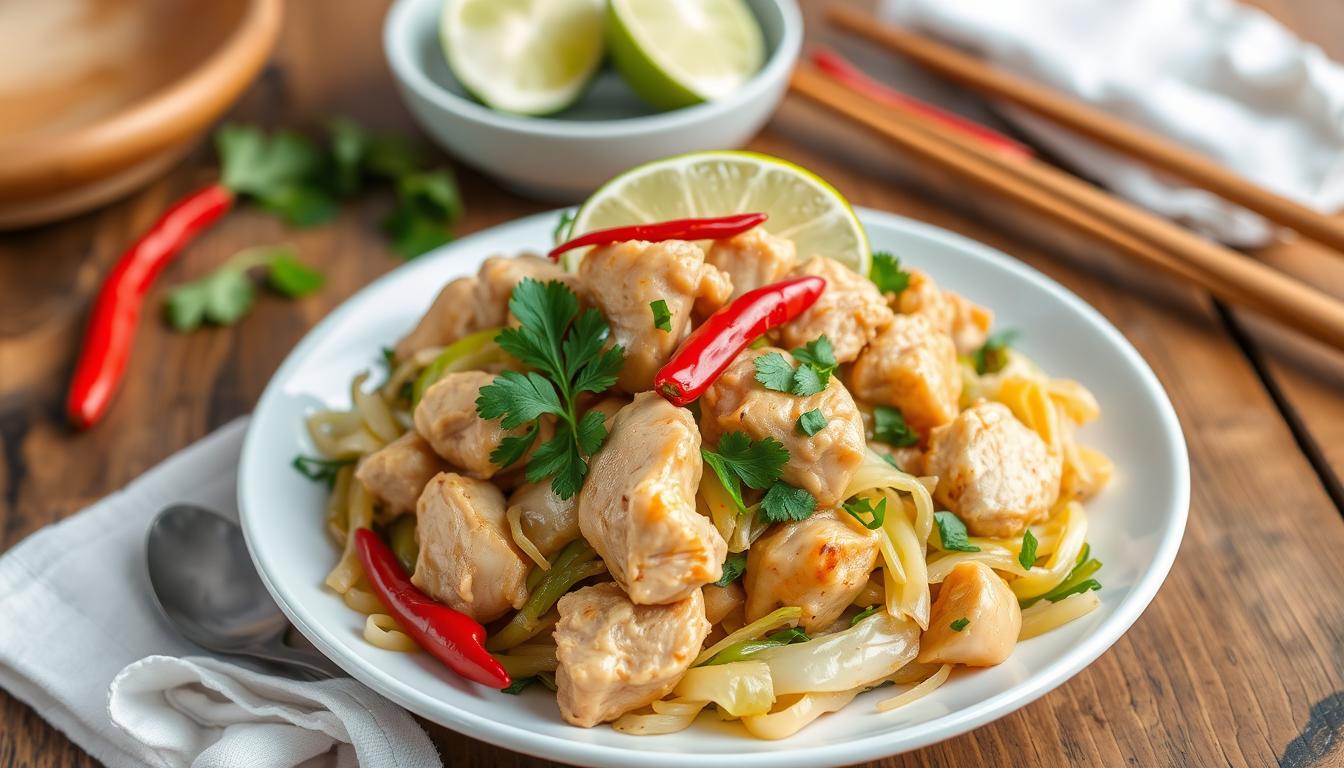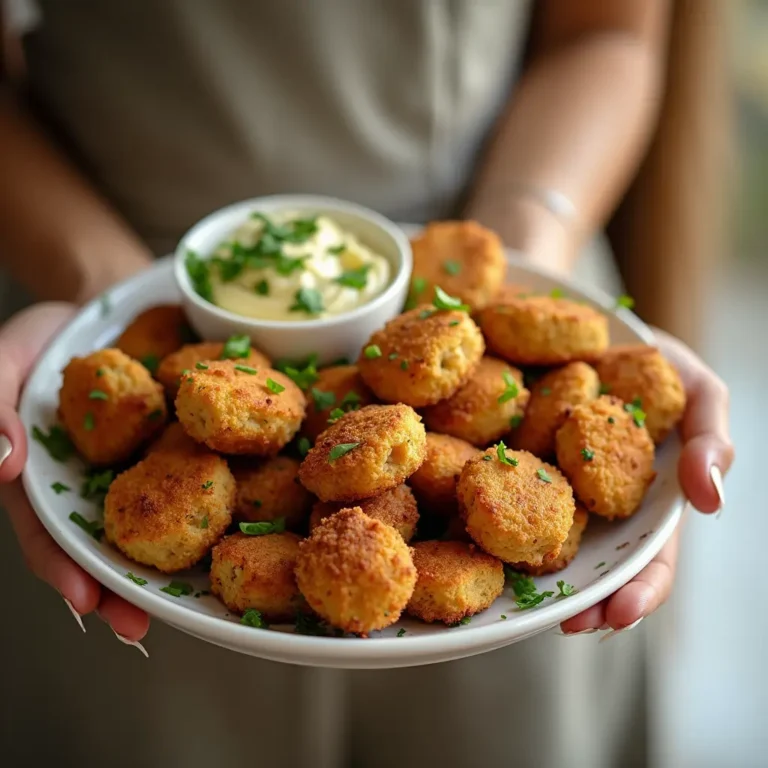My Delicious Hmong Cabbage and Chicken Recipe
Did you know over 20 million people worldwide love Hmong cuisine? It’s known for its bold flavors and fresh ingredients. I’m excited to share my favorite Hmong cabbage and chicken recipe with you. This dish is a staple at family gatherings and special occasions.
| Total Time | 35 min |
| Prep Time | 10 min |
| Cook Time | 25 min |
| servings | 6 |
| calores | 300 |
It’s a perfect mix of flavors and textures. This recipe is sure to become a favorite in your home.
The recipe serves 6 people and takes just 10 minutes to prepare. It cooks for 25 minutes. Each serving has 300 kcal, making it a healthy and tasty option for dinner.
You’ll need 1-1.5 lbs of chicken thighs, 4 cups of shredded green cabbage, and spices like soy sauce, oyster sauce, garlic, and ginger. I’ll share tips and tricks for making this authentic Hmong dish. Keep reading to learn more about this recipe and its cultural heritage.
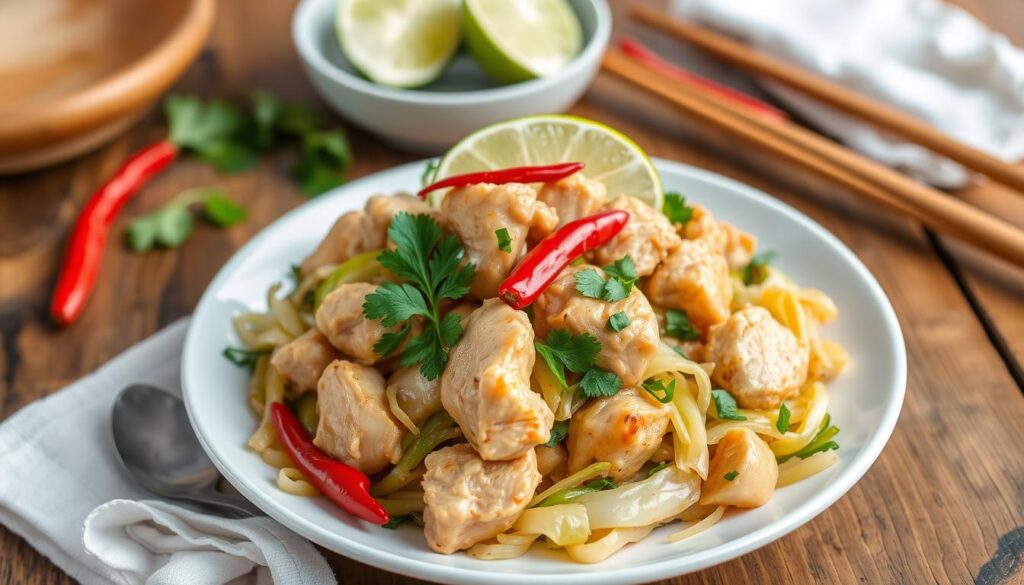
This traditional Hmong dish shows the Hmong people’s resourcefulness and creativity. They value fresh ingredients, bold flavors, and hearty portions. As a fan of authentic Hmong cuisine, I’m excited to share my knowledge and passion with you. I hope you’ll enjoy learning about the history and cultural significance of this delicious Hmong cabbage and chicken recipe.
Table of Contents
My Journey with Traditional Hmong Cuisine
Thinking about hmong cooking brings back memories of my family’s kitchen. My mother and grandmother would make traditional hmong dish with skill and love. The Hmong cabbage and chicken recipe was a favorite I learned from my mother.
Hmong recipe ideas are key in our culture. They unite us and create memories. The Hmong cabbage and chicken is a family favorite, often served at gatherings or with warm rice.
I’ve learned a lot about hmong cooking. Here are some important points:
- Using fresh, local ingredients like cabbage and chicken for the best taste and texture.
- Learning various cooking methods, like stir-frying and braising, for different traditional hmong dish.
- Trying new hmong recipe ideas to make tasty and unique meals.
My journey with hmong cooking has deepened my respect for food in our culture. I want to share my love for traditional hmong dish and hmong recipe ideas with others. I hope to inspire them to explore and keep our culinary traditions alive.
Understanding the Perfect Hmong Cabbage and Chicken Recipe
To make an authentic Hmong dish, knowing its origins and cultural value is key. This traditional recipe has been shared for generations. It includes chicken thighs, Napa cabbage, and spices like fish sauce and ginger.
For a tasty hmong cabbage and chicken recipe, use fresh ingredients and traditional cooking. Authentic hmong cuisine balances flavors with fish sauce, lime, and chili peppers. It’s often served with sticky rice, herbs, and herbal tea.
Origins of the Dish
The hmong cabbage and chicken recipe comes from traditional Hmong cuisine. It was a staple at family gatherings and special events. It shows the Hmong people’s creativity and resourcefulness with local ingredients.
Cultural Significance
In Hmong culture, food brings people together. The hmong cabbage and chicken recipe is served at special times. It symbolizes hospitality and community, and sharing it is a big part of Hmong tradition.
Regional Variations
While the basic ingredients stay the same, regional twists add unique flavors. Some areas use different cabbages or add lemongrass. These changes show the diversity and creativity of Hmong cuisine.
| Ingredient | Quantity |
|---|---|
| Chicken (boneless) | 500g |
| Green cabbage | 1 medium head |
| Garlic cloves | 4 |
| Ginger (1-inch piece) | 1 |
| Soy sauce | 3 tbsp |
| Fish sauce | 1 tbsp |
By learning about the hmong cabbage and chicken recipe’s origins, cultural importance, and regional differences, you can make a delicious traditional Hmong dish. It showcases the richness and diversity of Hmong cuisine.
Essential Ingredients for Authentic Flavor
To make a real Hmong dish, like chicken cabbage stir-fry, you need fresh, top-notch ingredients. The cabbage, chicken, and spices you choose greatly affect the taste and feel of the dish. For a simple Hmong recipe, use napa cabbage, boneless chicken thighs, garlic, ginger, and soy sauce.
In Hmong cooking, it’s all about finding the right balance of flavors and textures. A classic Hmong cabbage and chicken dish often includes fish sauce, chili peppers, and lemongrass. These add a rich, deep flavor, making the dish truly Hmong.
Here are the key ingredients for the chicken cabbage stir-fry:
- 1 pound of chicken (thighs or breast, thinly sliced)
- 4 cups of green cabbage, shredded
- 2 cloves of garlic and 1 small onion
- 2 tablespoons of cooking oil (vegetable or peanut oil)
- 2 tablespoons of soy sauce and 1 tablespoon of fish sauce
With these ingredients and a simple Hmong recipe, you can make a tasty, authentic chicken cabbage stir-fry. It will show off the rich flavors and traditions of Hmong cooking.
| Ingredient | Quantity |
|---|---|
| Chicken | 1 pound |
| Cabbage | 4 cups |
| Garlic | 2 cloves |
| Soy sauce | 2 tablespoons |
Kitchen Tools and Equipment Needed
To make a tasty traditional Hmong dish like the Hmong cabbage and chicken recipe, you need the right tools. As a fan of hmong food blogs, I know good tools make a big difference. A good wok or large skillet is key for stir-frying.
You’ll also need a knife and cutting board for chopping, a bowl for marinating chicken, and tongs or a spatula for cooking. For more hmong recipe ideas, a mandoline slicer and a meat thermometer can be helpful.
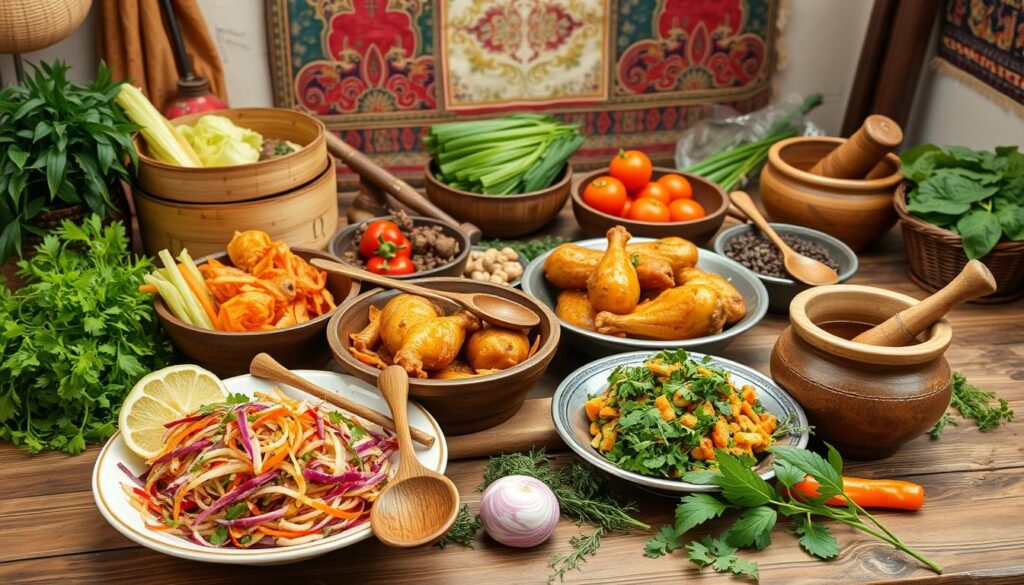
For a true Hmong dish, traditional utensils like a Hmong ladle and chopsticks are important. But, you can also use modern tools like stainless steel woks and non-stick pans. With the right tools, you can make many Hmong dishes, including the Hmong cabbage and chicken recipe.
Traditional Utensils
- Wok or large skillet
- Knife and cutting board
- Mixing bowl
- Tongs or spatula
Modern Alternatives
- Stainless steel wok
- Non-stick pan
- Mandoline slicer
- Meat thermometer
Preparation and Cooking Instructions
To start, marinate the chicken in a mix of soy sauce, garlic, and ginger. This step is key in hmong cooking as it brings out the flavor. You’ll need about 1.25 lbs of chicken breast for the chicken cabbage stir-fry. The marinade includes 1 tbsp of coconut aminos, 1.5 tsp of tapioca starch, 0.5 tsp of baking soda, 1/4 tsp of coarse sea salt, 2 tbsp of olive oil, and 1/8 tsp of white pepper.
After marinating, heat 2 tbsp of olive oil in a wok or large skillet over medium-high heat. Cook the chicken for 2-3 minutes on each side until it’s golden. Then, remove the chicken and set it aside. Add more oil if needed, and stir-fry the chopped cabbage. For an easy hmong recipe, using stir-frying and simmering techniques is key to a delicious Hmong dish.
Here are the steps to follow for the chicken cabbage stir-fry:
- Prepare the chicken by marinating it in a mixture of soy sauce, garlic, and ginger.
- Cook the chicken in a wok or large skillet over medium-high heat.
- Stir-fry the chopped cabbage and add the cooked chicken back into the wok.
- Season with salt, pepper, and any other desired herbs or spices.
By following these steps and using the right ingredients, you can make a delicious Hmong chicken cabbage stir-fry. This hmong cooking recipe is simple and requires just a few ingredients, making it perfect for a weeknight dinner. The mix of chicken, cabbage, and stir-fry sauce creates a tasty and fulfilling meal that everyone will enjoy.
My Secret Tips for Perfect Results
Creating a tasty traditional hmong dish is all about balance and harmony. For my Hmong cabbage and chicken recipe, I use top-notch ingredients and traditional cooking. This way, I make a dish that tastes great and looks good too.
I love trying out different hmong recipe ideas and ingredients to find the best mix. I also keep working on my cooking skills to add my own special touch. This helps me make a dish that’s truly unique and shows my love for hmong food blog and cooking.
Some top tips for me include: * Choosing fresh, seasonal ingredients for the best taste and texture * Mixing flavors and textures to make the dish balanced and tasty * Making the dish look good to enhance the eating experience
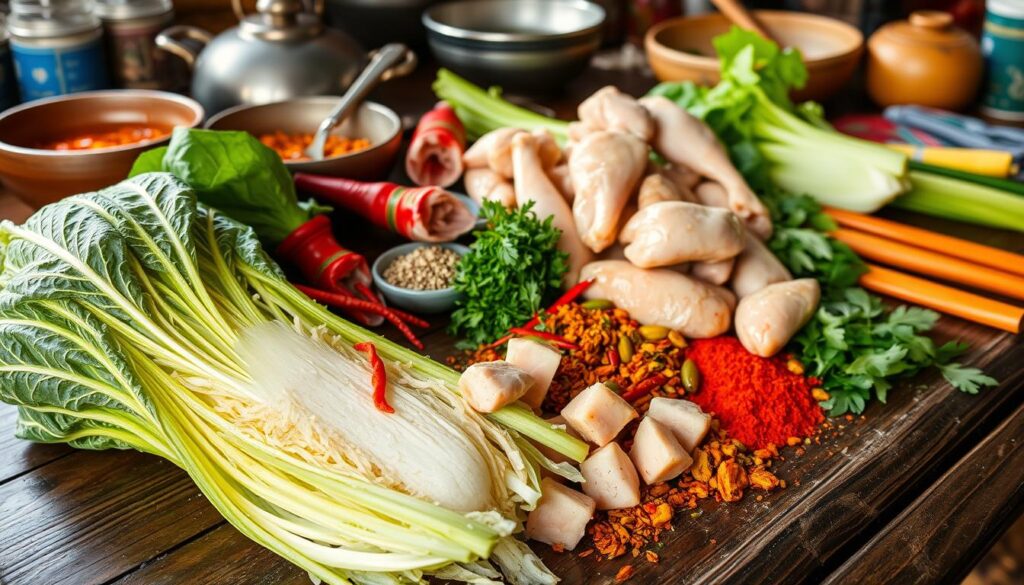
By sticking to these tips and always trying to improve, I make delicious and authentic traditional hmong dish. I’m proud to share it with others. Whether you’re a food blogger or just enjoy hmong food blog, I hope these tips help you in your cooking adventures.
Serving Suggestions and Pairings
When serving the hmong cabbage and chicken recipe, presentation matters. I serve it on a white or neutral plate. It’s garnished with fresh cilantro or green onions for color and freshness. This dish is not just tasty but also looks great, making it perfect for any meal.
Pairing the hmong cabbage and chicken with traditional sides like steamed jasmine rice or sticky rice enhances its flavors. Here are some other great pairings:
- Steamed vegetables, like broccoli or carrots, add nutrients and flavor.
- A cucumber salad or grilled vegetables offer a refreshing contrast.
- Hmong pepper sauce adds heat and flavor.
For a modern twist, try these pairings:
- Kimchi or pickled vegetables add a tangy, spicy kick.
- Toasted sesame seeds or chopped nuts add crunch and texture.
The hmong cabbage and chicken recipe is versatile and delicious. It’s perfect for those wanting to explore authentic hmong cuisine. Its rich flavors and traditional roots make it a favorite in any home.
By using these serving and pairing ideas, you can create a memorable meal. It showcases the best of traditional hmong cuisine and modern flavors. So, why not try it and enjoy the flavors of hmong cabbage and chicken for yourself?
| Traditional Accompaniments | Modern Fusion Twists |
|---|---|
| Steamed jasmine rice | Kimchi or pickled vegetables |
| Sticky rice | Toasted sesame seeds or chopped nuts |
| Cucumber salad | Grilled vegetables |
Health Benefits and Nutritional Information
Exploring hmong cooking, I’m thrilled to share the health perks of my favorite chicken cabbage stir-fry. This recipe is not just tasty but also full of nutrients that boost our health.
This dish has about 122 calories, 13g of protein, and 4g of fat per serving. It’s also loaded with vitamins A and C, calcium, and iron. Plus, it’s low in sodium and cholesterol, perfect for those watching their diet.
Protein Content
The chicken cabbage stir-fry is a great protein source, with 23g per serving. It’s perfect for those wanting to eat more protein.
Vitamin Profile
This dish is rich in vitamins A and C. A single serving gives you about 35IU of vitamin A and 29.5mg of vitamin C.
Dietary Considerations
For those with dietary needs, this recipe is low in calories and fat. It also has about 1g of dietary fiber per serving.
Here’s a quick look at the nutritional info per serving:
| Nutrient | Amount |
|---|---|
| Calories | 122 kcal |
| Protein | 13g |
| Fat | 4g |
| Carbohydrates | 7g |
| Fiber | 1g |
| Sugar | 3g |
| Vitamin A | 35IU |
| Vitamin C | 29.5mg |
Storage and Leftover Tips
As a fan of hmong food blog, I know how key proper storage is. For the classic hmong dish of cabbage and chicken, keeping it fresh is a must. Store leftovers in an airtight container in the fridge for up to three days.
Freezing is great for longer storage. Just put the leftovers in a freezer-safe container or bag. They can last up to two months in the freezer. To use them again, thaw in the fridge overnight or reheat in a wok or saucepan. You can also mix them into soups, salads, or sandwiches.
Here are some tips for reusing leftovers:
- Use them in soups or stews for added flavor and nutrition
- Add them to salads for a protein-packed meal
- Use them as a filling for sandwiches or wraps
By following these tips, you can enjoy your traditional hmong dish longer and cut down on waste. Always handle and store food safely to avoid contamination and illness.
| Storage Method | Storage Time |
|---|---|
| Refrigeration | Up to 3 days |
| Freezing | Up to 2 months |
Conclusion: Embracing Hmong Culinary Heritage
The Hmong cabbage and chicken recipe shows the rich flavors and cultural value of Hmong cuisine. It’s a delicious example of Hmong cooking, mixing savory, sweet, and tangy tastes.
Trying traditional Hmong recipes lets us enjoy great flavors and learn about Hmong culture. I suggest you make this recipe and try more Hmong dishes. It’s a way to experience the lively tastes of Hmong culture.
It’s important to share these traditional Hmong dishes with the next generation. This keeps Hmong culinary traditions alive and celebrated. Let’s celebrate Hmong cuisine with every delicious bite.
Your feedback is the secret ingredient! Share your review and help others enjoy the recipe as much as you did
There are no reviews yet. Be the first one to write one.

